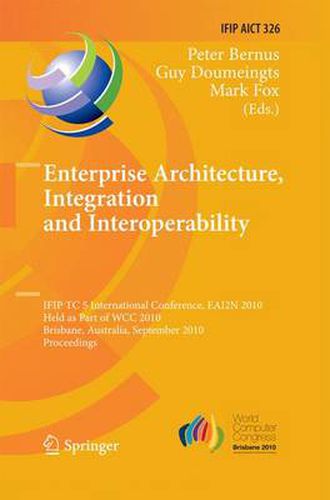Readings Newsletter
Become a Readings Member to make your shopping experience even easier.
Sign in or sign up for free!
You’re not far away from qualifying for FREE standard shipping within Australia
You’ve qualified for FREE standard shipping within Australia
The cart is loading…






This title is printed to order. This book may have been self-published. If so, we cannot guarantee the quality of the content. In the main most books will have gone through the editing process however some may not. We therefore suggest that you be aware of this before ordering this book. If in doubt check either the author or publisher’s details as we are unable to accept any returns unless they are faulty. Please contact us if you have any questions.
Enterprise Architecture, Integration, and Interoperability and the Networked enterprise have become the theme of many conferences in the past few years. These conferences were organised by IFIP TC5 with the support of its two working groups: WG 5. 12 (Architectures for Enterprise Integration) and WG 5. 8 (Enterprise Interoperability), both concerned with aspects of the topic: how is it possible to architect and implement businesses that are flexible and able to change, to interact, and use one another’s s- vices in a dynamic manner for the purpose of (joint) value creation. The original qu- tion of enterprise integration in the 1980s was: how can we achieve and integrate - formation and material flow in the enterprise? Various methods and reference models were developed or proposed - ranging from tightly integrated monolithic system - chitectures, through cell-based manufacturing to on-demand interconnection of bu- nesses to form virtual enterprises in response to market opportunities. Two camps have emerged in the endeavour to achieve the same goal, namely, to achieve interoperability between businesses (whereupon interoperability is the ability to exchange information in order to use one another’s services or to jointly implement a service). One school of researchers addresses the technical aspects of creating dynamic (and static) interconnections between disparate businesses (or parts thereof).
$9.00 standard shipping within Australia
FREE standard shipping within Australia for orders over $100.00
Express & International shipping calculated at checkout
This title is printed to order. This book may have been self-published. If so, we cannot guarantee the quality of the content. In the main most books will have gone through the editing process however some may not. We therefore suggest that you be aware of this before ordering this book. If in doubt check either the author or publisher’s details as we are unable to accept any returns unless they are faulty. Please contact us if you have any questions.
Enterprise Architecture, Integration, and Interoperability and the Networked enterprise have become the theme of many conferences in the past few years. These conferences were organised by IFIP TC5 with the support of its two working groups: WG 5. 12 (Architectures for Enterprise Integration) and WG 5. 8 (Enterprise Interoperability), both concerned with aspects of the topic: how is it possible to architect and implement businesses that are flexible and able to change, to interact, and use one another’s s- vices in a dynamic manner for the purpose of (joint) value creation. The original qu- tion of enterprise integration in the 1980s was: how can we achieve and integrate - formation and material flow in the enterprise? Various methods and reference models were developed or proposed - ranging from tightly integrated monolithic system - chitectures, through cell-based manufacturing to on-demand interconnection of bu- nesses to form virtual enterprises in response to market opportunities. Two camps have emerged in the endeavour to achieve the same goal, namely, to achieve interoperability between businesses (whereupon interoperability is the ability to exchange information in order to use one another’s services or to jointly implement a service). One school of researchers addresses the technical aspects of creating dynamic (and static) interconnections between disparate businesses (or parts thereof).